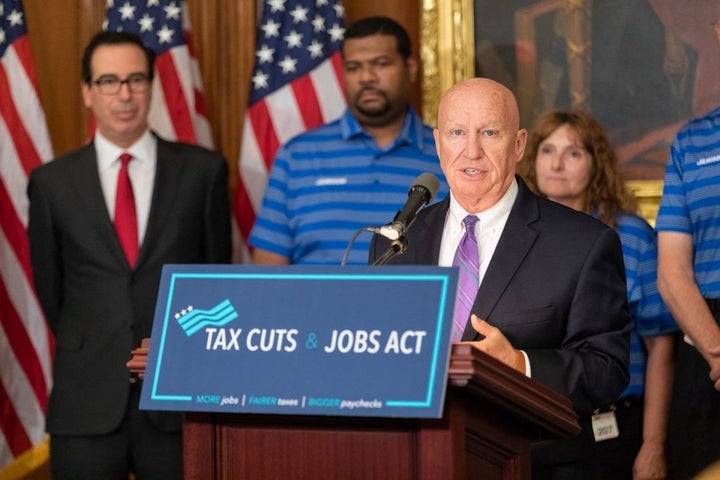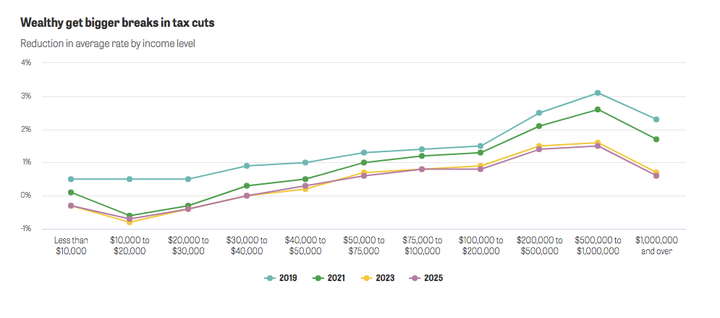
When President Donald Trump last year signed into law the biggest tax overhaul in three decades, many experts concluded it was clear that most of the cuts went to the wealthy. Less clear was that the cuts disproportionately favor whites over minorities — a gulf that will likely worsen a centuries-old economic divide between the races.
The Tax Cuts and Jobs Act, signed by Trump last December, cut the income tax rates across the board for large corporations and many small businesses and partnerships. Individuals received tax preferences in the form of a temporary increase in the child tax credit and the standard deduction. They also received temporary reductions in individual income tax rates.
But over the next few years, the cuts become less generous for those earning the least — and that disproportionately affects minorities far more than whites, according to tax experts and a Center for Public Integrity analysis using Census Bureau data.
Lawmakers should have been mindful of that fact when writing the law, said Jay Soled, director of the Masters of Accountancy in Taxation program at Rutgers University.
“The tax act largely and disproportionately helps Caucasians at the possible expense of those who are non-Caucasian,” Soled said. Republicans didn’t have “an agenda [of] ‘how do we hurt the non-Caucasians?’” But Congress “should be proactive in trying to reform the tax code in a way that doesn’t perpetuate or worsen income inequality,” he added.
The breakdown of tax cuts by race has implications for the upcoming midterm elections and for proposed additional tax cuts Republicans say they want to enact this fall. Earlier this year, Republicans seemed to feel that the cuts in last December’s the tax law would increase their chances for victory in this November elections — but that enthusiasm has since waned. So now many Republicans want to pass more tax cuts in the coming months, hoping that could further bolster their election prospects. Trump said in July that any new tax legislation passed this fall “will be more aimed at the middle class.”
Minorities get less
Starting next year, every income group will see their average tax rates drop. But rates for the super wealthy, those earning more than $200,000 a year, will decrease between 2.1 and 3.1 percent of their income, compared to half a percent for those earning less than $30,000, according to the Joint Committee on Taxation, a nonpartisan congressional panel that analyzes the effect of proposed tax changes in bills.
For later years, the disparities only become greater.
Between 2019 and 2025, many Americans earning less than $30,000 will see their taxes increase until their effective rates are actually higher, as much as 0.7 percentage points more than if the new tax law had not passed, according to the JCT. The wealthy will continue to pay at lower rates, as much as 1.5 percentage points lower.
That’s not only a bad deal for the poor; it has a disproportionate impact on blacks and Hispanics. Nearly 40 percent of black households earn less than $30,000, followed by 30 percent of Hispanic households, according to the Center’s analysis. Only 22 percent of white households earn less than $30,000.
The wealthy will retain slightly lower rates after 2025 mostly because of benefits from the permanent corporate tax cuts, which will increase some kinds of income such as dividends. Some of the biggest tax cuts in 2025 are for those earning more than $75,000, with rate reductions between 0.6 percent and 1.5 percent of income, according to JCT. About 44 percent of white Americans earn this amount compared with 24 percent of blacks and 30 percent of Hispanics, according to the Center’s analysis.


Obamacare impact
Several factors will cause taxes to increase for low-wage earners, said Thomas Barthold, chief of staff at the JCT. For instance, using a lower inflation-rate index to annually adjust the standard deduction and a tax credit for the poor will increase taxes for low- and middle-income individuals. Those with higher incomes will also be affected by the lower inflation-rate index.
But the biggest impact on low-wage earners, Barthold said, comes from the repeal of the Affordable Care Act’s individual mandate, which required Americans without health insurance to purchase it or pay a penalty to the Internal Revenue Service. Without the mandate, which expires at the end of this year, some taxpayers will choose not to buy health insurance. Low-income workers who opt out will lose the tax-credit subsidy the government provided them to help pay for insurance, Barthold said. JCT tallies the loss of the credit as an increase in net taxes.
Republicans argue JCT’s analysis of the tax changes shouldn’t include the repeal of the Obamacare mandate or the related loss of the Obamacare tax credit because Americans who qualify for it can still choose to buy health insurance and get the subsidy, and the credit isn’t directly paid to them.
They argue that the mandate itself is a tax because it forces Americans to buy health insurance, and the tax credit is paid directly to insurance companies, not to individual taxpayers.
“It is not a tax increase if a person decides they don’t want to buy an Obamacare plan and as a result we don’t send a payment to an insurance company,” Sen. Pat Toomey, R-Pa., said during a Finance Committee markup of the tax bill in November. “That’s a tax increase? It’s actually a tax cut.”
If the effect of repealing the individual mandate is not included, the tax rates for low- to middle-income Americans would decrease, not increase, according to an analysis Toomey and other Republicans asked JCT to conduct — though the decreases would still not be as much as the rate reductions for wealthy payers.
The poorest of the poor — those making less than $10,000 — will have no change in their tax rates in 2023 and 2025 compared with before the law, the only group of taxpayers without a tax rate decrease.
House Ways and Means Committee Chairman Kevin Brady, R-Texas, and the tax law’s sponsor, has called criticisms that the legislation benefits the wealthy more than the poor “baloney.” Brady argued shortly after Trump signed the bill into law that families in his home state of Texas would see on average $2,000 more a year in after-tax income.
“It’s saving for college tuition; it’s a utility bill,” Brady said, according to a post on his website. “Opponents of this aren’t worried about tax cuts for the rich, they’re worried about tax cuts for you.”
Brady didn’t respond to requests for comment about the Center’s analysis.
‘It makes you feel inferior’
Gail Hagwood said she isn’t surprised that the cuts will disproportionately affect minorities. Hagwood, 63, is the church administrator for the Galilean House of Worship in Henry County in southwestern Virginia. She said she noticed “a few dollars” more in her monthly paycheck since the tax law went into effect — but not enough to a make a difference in her lifestyle.

Hagwood said such a small bump in take-home pay for workers like her won’t be much economic help for the county, where many businesses throughout Martinsville, the county’s biggest town, with a population 13,100, remain boarded up. High grass grows on some empty lots. For most of the 20th century, the county had thriving textile and furniture industries, but they began leaving the area in the 1990s as the work moved to lower-wage countries. Although the county recently recorded its lowest unemployment rate in 18 years, at 3.8 percent, the poverty rate remains stubbornly high — 19 percent of people live below the poverty line compared with the national average of 12.7 percent. About 55 percent of Hispanics and 21 percent of blacks in the county live in poverty.
When Congress was debating the tax law last year, Hagwood said she knew immediately it was going to be unfair to low-income workers because she expected wealthy lawmakers to pass legislation that benefited people like them. When she was told the tax cuts went disproportionally to whites, she laughed in resignation.
“You already know it, but when you actually see [the racial income gap], it hurts,” Hagwood said, sitting behind her desk in her church office, decorated with Bible verses and family photos. “It makes you feel inferior.”
Hagwood is part of a large majority of black Americans who don’t believe the Trump tax cuts will help them. According to a recent national survey, only 16 percent of black respondents said the new tax law will help their family’s finances, while 34 percent, still only a third, of white respondents said they believed it would help their families.
Republicans and conservative tax analysts argue the racial disparity of who gets more money will equalize, and eventually the tax cuts will benefit everyone, despite race. They contend that giving heftier tax cuts to the wealthy leads to investment, which in turn creates jobs and boosts wages for everyone — a controversial theory, derided by critics as “trickle-down economics,” that was used to defend tax cuts passed under President Ronald Reagan in 1981.
That’s what will likely happen with the Trump tax cuts, said Horace Cooper, co-chairman of the Project 21 National Advisory Board, an initiative within the National Center for Public Policy Research that promotes the views of conservative African-Americans. The approach creates more economic growth because those at the top of the income ladder, not the bottom, are the ones who will take money from tax cuts to invest in businesses, creating jobs and increasing wages, he said.
“The thing is, the least able will have a little bit more money so that they can pay their electricity bill. They have a little bit more money so they can splurge at the grocery store,” Cooper said. “But what they won’t do is generate wholesale job creation.”
Cooper said he sees only upsides for people of color in the Trump tax cut law.
“If black Americans have been marginalized because they were stranded on areas where there wasn’t investment, this tax plan and the new pro-business mindset is more likely to see to it that the waters reach those islands and help people,” Cooper said.
Economists such as Rutger’s Soled say there’s no conclusive evidence that trickle-down economics creates jobs and increases wages for lower income workers.
While no one believes the Republican authors of the tax bill intentionally planned to give smaller tax cuts to minorities, the law, nevertheless, does just that. In so doing, the law perpetuates a deep racial economic inequality in which whites’ median household income is nearly two-thirds more than blacks’.
Michael Linden, a fellow at the Roosevelt Institute, a liberal think tank in Washington, D.C., said the Trump tax law is “certainly not good for communities of color, but it’s not good for anybody if there are these special barriers or disproportionate blockades to opportunity and improvement and dignity.” It’s “unacceptable in a modern society,” he said, “for us to have different economic systems for different people.”
“You already know it, but when you actually see [the racial income gap], it hurts, It makes you feel inferior.”
- —Gail Hagwood, Virginia resident
Making inequality worse
One of the lasting negative effects of the tax law is it will perpetuate racial income inequality. A report released in May by the Roosevelt Institute argued that income and wealth inequality hinders economic opportunity, mobility and security.
“Compared to income disparities, racial wealth disparities are more severe and generationally established, and thus they have a much more intense and lasting impact that the tax law will exacerbate,” the report said.
In 2016, the median household income for white families was $65,041, about 65 percent more than black households’ median income of $39,490, and 36 percent more than Hispanic households, who earned $47,675, according to the Census Bureau’s Current Population Survey. The gap improved from 2015, when the median household income for whites was 70 percent more than black households and 39 percent more than Hispanic households.
But the tax law will do nothing to close the gap more, and may make it worse, some tax experts said.
“The legislation is certainly not helping [people of color] by trying to equalize wealth or equalize incomes or anything like that,” said Elaine Maag, a senior research associate at the Urban-Brookings Tax Policy Center.
Maag said it is not unheard of for Congress to examine how their policies could affect different people at various income levels, but she doesn’t expect Congress to consider that in any future tax cut bills this fall. After all, she said, Congress had data showing how the new tax law provided only modest, at best, benefits for low- to middle-income families, “and that did not persuade them to rethink how these families would be treated.”
For Hagwood, the fact that Congress didn’t consider race when determining who got the biggest tax cuts is confirmation that lawmakers don’t have her or other minorities in mind when writing tax legislation.
“We’ve got to see ourselves as equal, and we’re never seen as equal,” Hagwood said. “[The tax law] shows you we’re not equal.”
The Center for Public Integrity is a nonprofit, nonpartisan investigative news organization in Washington, D.C.